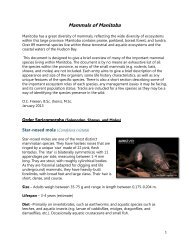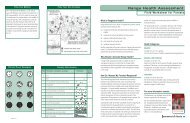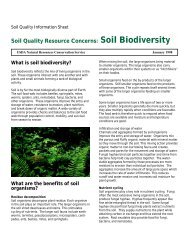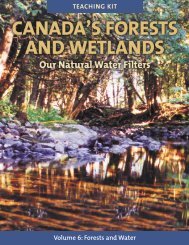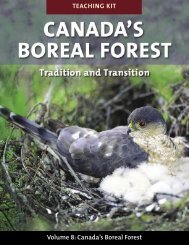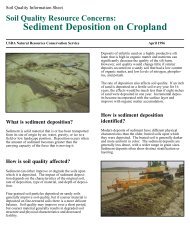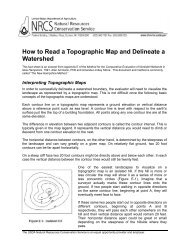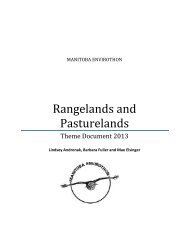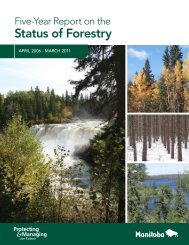COLDWATER FISH - Manitoba Forestry Association
COLDWATER FISH - Manitoba Forestry Association
COLDWATER FISH - Manitoba Forestry Association
- No tags were found...
You also want an ePaper? Increase the reach of your titles
YUMPU automatically turns print PDFs into web optimized ePapers that Google loves.
National Factsheets - Fish Fact Sheet - Yellow PerchCANADIAN WATERS - InfocentreNational Factsheet - Yellow PerchGeneral DescriptionThe yellow perch is a member of the perch family of fishes and has the following characteristics:an elongate, oval body;a moderately long, blunt snout which does not extend beyond the lower jaw;two well separated dorsal fins;the back and top of the head are bright green to olive to golden brown and this colour extends downwardsto form six to eight vertical bars over the yellow to yellow-green sides;the underside is white; andthe dorsal and caudal fins are yellow to green, anal and pelvic fins opaque yellow to silver white and thepectoral fins amber and transparent.DistributionThe yellow perch is a freshwater fish with an almost circumpolar distribution in the northern hemisphere. InCanada it can be found from Nova Scotia and Quebec, west to Great Slave Lake in the Northwest Territories andin Pend The yellow perch is a freshwater fish with an almost circumpolar distribution in the northern hemisphere.In Canada it can be found from Nova Scotia and Quebec, west to Great Slave Lake in the Northwest Territoriesand in Pend Oreille, Kootenay and Okanagan watersheds of British Columbia. This small, prolific fish is especiallyabundant in <strong>Manitoba</strong> lakes and in the Great Lakes drainage system.Habitat and Life HistoryThe yellow perch is a cool-water species and is most abundant in the open water of lakes with moderatevegetation, clear water and bottoms of muck to sand and gravel. The yellow perch spawns in the spring, usuallyfrom mid-April to May. Adults migrate to the shallow waters of lakes and often into tributary rivers to spawn.Spawning takes place during the night and early morning, usually near rooted vegetation, submerged brush orfallen trees, but sometimes over sand or gravel. The eggs hatch in approximately 8 - 10 days and the youngremain inactive for about 5 days. Young fish feed on cladocerans, ostracods and chironomid larvae. In the firstsummer large, compact schools of the young are often seen. Adults and young are gregarious, often movingabout in loose groups of 50-200 individuals. Yellow perch move seasonally out of and into deeper water inresponse to temperature and, probably, to food distribution.Food HabitsThe food of the yellow perch changes with size and season but it is mainly composed of immature insects, largerfile:///C|/...ocuments/ENVIROTHON/Envirothon MFA/Envirothon 2009/Resources Guides/Aquatics/Aquatics Binder/binder/fishspecies.htm[09/11/2009 1:39:11 PM]
National Factsheets - Fish Fact Sheet - Yellow Perchinvertebrates, and the eggs and young of a wide variety of fishes. It is an active feeder during the whole year andcan be angled summer and winter.Economic ImportanceThe yellow perch is an important commercial, recreational and sport fish. Because it inhabits a vast territory, awide variety of habitats, is a schooling fish and congregates near shore in the spring, it is readily available tocommercial and recreational fishermen. Today it is the most valuable commercial catch taken from Ontario watersand the greatest commercial production comes from the Great Lakes.Yellow perch is an excellent food fish and is marketed fresh and frozen.Fishing FactsThe yellow perch may be the easiest of all fish to catch and is a favourite sport fish of children.Further InformationReferrals CoordinatorOntario-Great Lakes AreaFish Habitat Management ProgramFisheries and Oceans Canada867 Lakeshore RoadBurlington, ON L7R 4A6Telephone (905) 336-4595referralsontario@dfo-mpo.gc.caCANADIAN WATERS - InfocentreNational Factsheet - WalleyeGeneral DescriptionThe walleye is the largest member of the perch family of fishes and has the following characteristics:an elongate, slightly compressed body and a bluntly pointed head;a long, blunt snout which does not extend beyond the upper jaw;file:///C|/...ocuments/ENVIROTHON/Envirothon MFA/Envirothon 2009/Resources Guides/Aquatics/Aquatics Binder/binder/fishspecies.htm[09/11/2009 1:39:11 PM]
National Factsheets - Fish Fact Sheet - Yellow Perchthe back and top of the head are dark green; the sides are golden yellow; and the underside is milk-whiteor yellow-white; andthe dorsal and caudal fins are speckled, the pelvic fins are yellow or orange-yellow; and the pectoral finsare dark or pale olive.DistributionThe walleye is native to the freshwaters of North America. In Canada, it can be found in the St. Lawrence tributaries inQuebec, north to the east coast of upper James Bay, northwest from the Hudson Bay coast in Ontario to Athabasca, GreatSlave and Great Bear Lakes, north in the MacKenzie River to the delta, south through the Peace River drainage ofnortheastern British Columbia and south, east of the foothills, to southern Alberta.Habitat and Life HistoryThe walleye is a cool-water species that prefers turbid waters in either large, shallow lakes or rivers, provided they are deeporturbid enough to give shelter in daylight. As their eyes are very sensitive to bright light, walleye often use sunken trees,boulders, weed beds, or thick layers of ice and snow as a shield from the sun. In more turbid water, walleye are more activeduring the day. Walleye spawn in the spring or early summer, depending on latitude and water temperature. Adults migrate tothe rocky areas in white water below impassable falls and dams in rivers, or boulder to coarse-gravel shoals of lakes.Spawning takes place at night and the eggs fall into crevices in the rocky substrate. The eggs hatch in 12 - 18 days and by 10- 15 days after hatching, the young disperse into the upper levels of open water.Food HabitsAs the walleye increases in size, its diet shifts from invertebrates to fishes. It is an active feeder during the whole year and canbe angled summer and winter.Economic ImportanceThe walleye is a major commercial and sport fish in Ontario and the Prairie Provinces, and a sport fish in Quebec. It is animportant species in both the summer sport fishery and for ice fishermen in the winter.Walleye is easily filleted and prepared and is a prime species on the market.Fishing FactsWalleye form a dominant part of the fish fauna of central Canada, particularly in the boreal forest zone.Further InformationReferrals CoordinatorOntario-Great Lakes AreaFish Habitat Management ProgramFisheries and Oceans Canada867 Lakeshore RoadBurlington, ON L7R 4A6Telephone (905) 336-4595referralsontario@dfo-mpo.gc.caCANADIAN WATERS - InfocentreNational Factsheet - Northern Pikefile:///C|/...ocuments/ENVIROTHON/Envirothon MFA/Envirothon 2009/Resources Guides/Aquatics/Aquatics Binder/binder/fishspecies.htm[09/11/2009 1:39:11 PM]
National Factsheets - Fish Fact Sheet - Yellow PerchGeneral DescriptionThe northern pike is a member of the pike family of fishes and has the following characteristics:a long, slender, laterally compressed body;a long, broad, flattened snout;the dorsal and anal fins are located at the end of the body near the tail;the back, upper sides and the top and upper parts of the head are a dark brilliant green through olivegreento almost brown;the sides are conspicuously marked with longitudinal rows of yellow to whitish bean-shaped spots;the underside is cream to milk-white;the dorsal, caudal and anal fins are green to yellow, sometimes orange or pale red, with irregular blackmarkings. The paired fins are buff and usually unmarked.DistributionThe northern pike is primarily a freshwater fish with a circumpolar distribution in the northern hemisphere. It is oneof the few species that is found in rivers and lakes throughout Quebec, Ontario, the Prairie Provinces, thenortheast corner of British Columbia, in the Yukon, Nunavut and Northwest Territories.Habitat and Life HistoryThe northern pike is a cool-water species and its habitat is usually warm, slow, heavily vegetated rivers or theweedy bays of lakes. The northern pike spawns in the spring immediately after the ice melts. The breedinggrounds include areas that flood only in the spring and early summer and may be dry the remainder of the year.During spawning, they swim through the vegetated areas of shallow water and the eggs are scattered at randomand attach to the vegetation. The eggs hatch in approximately 12 - 14 days and the young remain attached to thevegetation for 6 - 10 days. The young remain in the shallow spawning areas for several weeks after hatching.Young pike feed on larger zooplankton and immature aquatic insects until they reach about 5 cm (2 inches) inlength, when fish becomes their main diet. Typically, adult pike do not migrate far from spawning grounds.Food HabitsUsually solitary and highly territorial, the northern pike lurks at the edge of weed beds and attacks unwarycreatures that enter its domain, such as fish, crayfish, frogs, mice, muskrats and young waterfowl. It is anopportunist that can be best described as an omnivorous carnivore, as it feeds on whatever is most readilyavailable.Economic ImportanceIn most areas of Canada, the northern pike is both a commercial fish and a sport fish, while in other areas it isconsidered a nuisance because it devours large numbers of other game fish such as trout, bass and perch.Anglers enjoy pike as they are aggressive fighters.The northern pike is an excellent food fish, which is marketed fresh and frozen.Fishing Factsfile:///C|/...ocuments/ENVIROTHON/Envirothon MFA/Envirothon 2009/Resources Guides/Aquatics/Aquatics Binder/binder/fishspecies.htm[09/11/2009 1:39:11 PM]
National Factsheets - Fish Fact Sheet - Yellow PerchThe hybrid of the northern pike and muskellunge is known as the "tiger muskellunge".Further InformationReferrals CoordinatorOntario-Great Lakes AreaFish Habitat Management ProgramFisheries and Oceans Canada867 Lakeshore RoadBurlington, ON L7R 4A6Telephone (905) 336-4595referralsontario@dfo-mpo.gc.caCANADIAN WATERS - InfocentreNational Factsheet - Lake WhitefishGeneral DescriptionThe lake whitefish is a member of the salmon family and has the following characteristics:a small head with a blunt snout over hanging the lower jaw;old fish may develop a hump behind the head (nuchal hump);the back is a pale greenish brown (Great Lakes) and sometimes dark brown to black (inland lakes);the sides of the adults have an overall silvery appearance;the underside is silvery white; andthe fins are usually clear or lightly pigmented (Great Lakes) but further north the fins are often darker.DistributionThe lake whitefish inhabits large rivers and cold freshwater lakes across Canada from New Brunswick andLabrador through to British Columbia, and the Northwest Territories. The northern limit of range in Canada for thisspecies is near Victoria Island in Nunavut.Habitat and Life HistoryThe lake whitefish is a cool-water species that moves from shallow to deep water as warming occurs and back tofile:///C|/...ocuments/ENVIROTHON/Envirothon MFA/Envirothon 2009/Resources Guides/Aquatics/Aquatics Binder/binder/fishspecies.htm[09/11/2009 1:39:11 PM]
National Factsheets - Fish Fact Sheet - Yellow Perchshallow water in the cooler months. Lake whitefish spawn in the fall, usually November and December in theGreat Lakes area and earlier further north. Spawning usually occurs in shallow water at depths of less than 7.6 m(25 feet) over a hard or stoney bottom and sometimes over sand. The spawning fish are quite active and havebeen observed to leap out of the water. The eggs are deposited at random over the spawning grounds andremain there until they hatch in April or May the following year. The larvae form aggregations with other speciesalong steep shorelines. Young whitefish generally leave the shallow inshore waters and move into deeper water inthe early summer.Food HabitsAdult lake whitefish are bottom feeders and their diet includes small fishes, fish eggs, aquatic insect larvae, clams,snails and plankton.Economic ImportanceThe lake whitefish is one of the most economically valuable freshwater species of the Northwest Territories andthe Prairie Provinces, the lakes of which are the largest producers of this species of fish.The fine flavour of lake whitefish has been extolled since the days of the early explorers. Its meat is marketedfresh, smoked and frozen, and the roe is marketed as “golden caviar”.Fishing FactsThe Lake Simcoe whitefish is a distinct stock of lake whitefish found only in Lake Simcoe, Ontario. The LakeSimcoe whitefish is listed as threatened by COSEWIC (Committee on the Status of Endangered Wildlife inCanada).Further InformationReferrals CoordinatorOntario-Great Lakes AreaFish Habitat Management ProgramFisheries and Oceans Canada867 Lakeshore RoadBurlington, ON L7R 4A6Telephone (905) 336-4595referralsontario@dfo-mpo.gc.caCANADIAN WATERS - InfocentreNational Factsheet - Smallmouth Bassfile:///C|/...ocuments/ENVIROTHON/Envirothon MFA/Envirothon 2009/Resources Guides/Aquatics/Aquatics Binder/binder/fishspecies.htm[09/11/2009 1:39:11 PM]
National Factsheets - Fish Fact Sheet - Yellow PerchGeneral DescriptionThe smallmouth bass is a member of the sunfish family and has the following characteristics:a robust, laterally compressed body;a large, long, head with dark bars which radiate back from the eyes;a long, blunt snout with a slightly longer lower jaw;two joined dorsal fins which appear as one;the back and top of the head are brown, golden brown through olive to green;the sides are lighter than the back, more golden with golden flecks on most scales and marked by 8 - 15pronounced to vague, thin vertical bars;the underside is cream to milk-white; the pectoral fins are clear and the others are opaque, dark to amberwith some black on rays, spines or membranes;the body colour is variable with size, condition and habitat: in clear water hey are darker with pronounced,contrasting markings; and, in turbid water they are lighter with vague markings.DistributionThe smallmouth bass is a freshwater fish that is native to the lakes and rivers of eastern central North America. InCanada, it occurs in southern Nova Scotia, southern and western New Brunswick, southern Quebec, throughOntario at the latitude of Timmins, at the south end of Lake Winnipeg in <strong>Manitoba</strong>, in central Saskatchewan, inthe Columbia River system of eastern British Columbia and Saltspring and southern Vancouver Island.Habitat and Life HistoryThe smallmouth bass is a warm-water fish species, usually found in rocky and sandy areas of lakes and rivers inmoderately shallow water and near rocks of shoals or submerged logs. It is less often associated with densegrowths of aquatic vegetation than largemouth bass. The smallmouth bass spawns in late spring and earlysummer, usually from late May to early July. The male builds a nest in 61 - 610 cm (2 - 20 feet) of water on asandy, gravel, or rocky bottom, of lakes and rivers, usually near the protection of rocks or logs. After spawning,the male guards the nest and fans the eggs. The eggs hatch in approximately 4 - 10 days and the young areabout 5.6 - 5.9 mm in length. After 5 - 7 days, the young begin to leave the nest, but are guarded by the male forseveral days.Food HabitsThe food of the smallmouth bass is mainly composed of insects, crayfish and fishes. The smallmouth bass takesthis variety of food from the surface, in the water column, and off the bottom.Economic ImportanceThe smallmouth bass is an important commercial, recreational and sport fish. It is one of the most important fishesin the huge sport fishery and associated tourist industries in eastern Canada.The smallmouth bass is an excellent food fish, marketed fresh and frozen.Fishing FactsThe sunfish family of fishes includes some of the most highly coloured and attractive North American warm-waterfile:///C|/...ocuments/ENVIROTHON/Envirothon MFA/Envirothon 2009/Resources Guides/Aquatics/Aquatics Binder/binder/fishspecies.htm[09/11/2009 1:39:11 PM]
National Factsheets - Fish Fact Sheet - Yellow Perchfishes.The smallmouth bass hybridizes in nature with the spotted bass.Further InformationReferrals CoordinatorOntario-Great Lakes AreaFish Habitat Management ProgramFisheries and Oceans Canada867 Lakeshore RoadBurlington, ON L7R 4A6Telephone (905) 336-4595referralsontario@dfo-mpo.gc.caCANADIAN WATERS - InfocentreNational Factsheet - Channel CatfishGeneral DescriptionThe channel catfish is the largest of the catfishes in Canada and has the following characteristics:a large, less rounded body than other catfishes with a large, long, wide head, which is flat to slightlyrounded on top;a short, wide mouth with a broad, flat undersurface and 4 pairs of darkly coloured barbels;the back, top of the head and upper sides are steel-blue to grey;the lower sides and the underside are dirty white to silver-white;the fins are the same colour as the body and the caudal fin is forked (theonly catfish in Canada with aforked tail); andbreeding males are often brighter blue in colour.DistributionThe channel catfish is native to the fresh waters of eastern and central North America. In Canada, it occurs in theSt. Lawrence River and its tributaries, in southern Quebec, the Ottawa River and tributaries, all the Great Lakesfile:///C|/...ocuments/ENVIROTHON/Envirothon MFA/Envirothon 2009/Resources Guides/Aquatics/Aquatics Binder/binder/fishspecies.htm[09/11/2009 1:39:11 PM]
National Factsheets - Fish Fact Sheet - Yellow Perchexcept Lake Superior, all of Ontario at the level of Lake Nipissing and the French River to Lake Superior, and inthe Nelson River system of extreme western Ontario and <strong>Manitoba</strong>. Of the Prairie Provinces, it is known to occuronly in <strong>Manitoba</strong> and as far north as Lake Winnipegosis and the Little Waterhen River.Habitat and Life HistoryThe channel catfish is a warm-water species found usually in cool, clear, deeper water with sand, gravel or rubblebottoms. During the day, they are most often found in the protection of rocks or logs. Although they are mainlysedentary animals, channel catfish undergo local movements in lakes and into tributary streams to feed. Channelcatfish spawn in late spring or summer and, depending on the habitat, they may or may not migrate into rivers ormoving water at spawning time. Spawning takes place in secluded, semidark nests built by the male in holes,undercut banks, log jams or rocks. After spawning, the males protect the nest and fan and clean the eggs withtheir fins. The eggs hatch in about 5 - 10 days and the young lie on their sides in the nest for 2 - 5 days, afterwhich time they swim to the surface and begin to feed. Like other catfishes, the male probably broods the young,after which time they disperse.Food HabitsChannel catfishes feed on or near the bottom, during the day and at night. They feed on a wide variety of plantand animal material, which includes mayflies, caddisflies, chironomids, molluscs, crayfish, crabs, green algae,larger water plants, tree seeds, fishes and, rarely, birds. While feeding at night, the channel catfish uses mainly itsbarbels to search for food; however, it may use mainly sight during the day in its clearer habitat.Economic ImportanceThe channel catfish is an important commercial fish in the Great Lakes and St. Lawrence River, a challengingsport fish and an excellent food fish.Fishing FactsThere is a hybrid between the channel catfish and the flathead catfish.Aboriginal artifacts have always included the spines of this and other species of catfishes, which were used asawls for leather-work or needles.Further InformationReferrals CoordinatorOntario-Great Lakes AreaFish Habitat Management ProgramFisheries and Oceans Canada867 Lakeshore RoadBurlington, ON L7R 4A6Telephone (905) 336-4595referralsontario@dfo-mpo.gc.caCANADIAN WATERS - InfocentreNational Factsheet - Lake Sturgeonfile:///C|/...ocuments/ENVIROTHON/Envirothon MFA/Envirothon 2009/Resources Guides/Aquatics/Aquatics Binder/binder/fishspecies.htm[09/11/2009 1:39:11 PM]
National Factsheets - Fish Fact Sheet - Yellow PerchGeneral DescriptionThe lake sturgeon is a member of the sturgeon family of fishes and has the following characteristics:a heavy, torpedo-shaped body with a very tough skin and prominent rows of bony plates or shields;a large, ventral, suctorial mouth and 4 barbels in front of it;the back and sides are olive-brown to grey and the underside is white;the dorsal and lateral shields are the same colour as the body; andthe fins are dark brown or grey with the single, dorsal fin far back near the caudal fin.DistributionThe lake sturgeon is native to large rivers and lakes in North America. In Canada, it is found from Hudson -James Bay as far north as Fort George River on the east and Seal River on the west; areas of Alberta,Saskatchewan and <strong>Manitoba</strong>; all of the Hudson Bay and Great Lakes drainages of Ontario, including all the GreatLakes; and, east to the end of freshwater in the St. Lawrence River.Habitat and Life HistoryThe lake sturgeon is a cold-water species found usually in shoal areas of large lakes and rivers. They are bottomdwellers, adapted to feeding on the mud or gravel and mud bottom. They spawn from early May to late June andmigrate to the spawning rivers after the ice melts. Spawning migrations out of lakes and up rivers to suitablegrounds are often as long as 128 km (80 miles). They spawn in depths of 61 - 457 cm (2 - 15 feet) and in areasof swift water or rapids, often even at the foot of low falls that prevent further migration. The spawning fish arequite active and have been observed to leap out of the water. The adhesive eggs are scattered and adhere torocks and logs and hatch in 5 - 8 days. Other than spawning migrations, seasonal movements of the lakesturgeon are thought to consist of a move from shallow waters when these warm, into deeper water, a return tothe shoals in fall, and a return to moderate depths in winter.Food HabitsLake sturgeons feed almost exclusively on small organisms they obtain from the bottom by means of theprotrusible, tube-like mouth and the sensory barbels. They are omnivorous (i.e. feeding on both animals andplants) and virtually anything edible that enters the mouth is sucked up and consumed.Economic ImportancePrior to 1860, the lake sturgeon was considered a nuisance and was either killed and dumped back in the lake,piled up on shore to dry to be burned (e.g. boilers of steamboats), or fed to pigs. Since then, the intense,indiscriminate fishery, and the effects of dams and pollution on the opportunity and the ability of the species toreproduce, have all contributed to the present low levels of populations of lake sturgeons.Lake sturgeon is now a gourmet item: the flesh, especially when smoked, is delicious although rich and oily, andthe eggs are marketed as caviar. Usually eggs of the lake sturgeon command a higher price than those of otherNorth American sturgeon.Fishing FactsThrough the Convention on International Trade in Endangered Species of Wild Fauna and Flora (CITES),file:///C|/...ocuments/ENVIROTHON/Envirothon MFA/Envirothon 2009/Resources Guides/Aquatics/Aquatics Binder/binder/fishspecies.htm[09/11/2009 1:39:11 PM]
National Factsheets - Fish Fact Sheet - Yellow Perchinternational trade of lake sturgeon is restricted.Further InformationReferrals CoordinatorOntario-Great Lakes AreaFish Habitat Management ProgramFisheries and Oceans Canada867 Lakeshore RoadBurlington, ON L7R 4A6Telephone (905) 336-4595referralsontario@dfo-mpo.gc.caCANADIAN WATERS - InfocentreNational Factsheet - Brown BullheadGeneral DescriptionThe brown bullhead is a member of the catfish family and has the following characteristics:a heavy, rounded body with a large, wide head;a wide, terminal mouth with 4 pairs of dark brown to black barbels;the back, top of the head and sides are yellow-brown, olive, grey to almost blue-black;the lower sides are dirty white and the underside is pale yellow to white;the fins are the same colour as the body but paler and there is some darker pigment on ray membranes.DistributionThe brown bullhead is native to the freshwaters of eastern and central North America. In Canada, it is found fromNova Scotia, through New Brunswick, the southern tip of Quebec, across southern Ontario at the level of LakeNipissing, to the north shore of Lake Superior, through southern <strong>Manitoba</strong> and as far west as the Whitesand-Assiniboine system of southeast Saskatchewan. In British Columbia, it was introduced in the lower Fraser Riverand several lakes on lower Vancouver Island.Habitat and Life Historyfile:///C|/...ocuments/ENVIROTHON/Envirothon MFA/Envirothon 2009/Resources Guides/Aquatics/Aquatics Binder/binder/fishspecies.htm[09/11/2009 1:39:11 PM]
National Factsheets - Fish Fact Sheet - Yellow PerchThe brown bullhead is a warm-water species found usually near or on the bottom in shallow, warm watersituations, in ponds, small lakes, shallow bays of larger lakes, and larger slow-moving streams with abundantaquatic vegetation, and sand to mud bottoms. The brown bullhead spawns in the late spring and summer,probably May and June in Canada. One or both sexes clear a shallow nest in a bottom of mud or sand or amongthe roots of aquatic vegetation, usually near the protection of a stump, rock or tree. They will also nest underboards, in hollow stumps, and even inside automobile tires nailed on docks. The water over these nesting sitescan be as shallow as 15 cm (6 inches) or as deep as several feet. After spawning, the eggs are cared for by oneor both parents. They fan and manipulate them with their barbels and this is necessary for the eggs to hatch.After about 6 - 9 days, the eggs hatch and the young lie on their sides in the nest until about the seventh day.The juveniles are guarded by one or both parents in a school for several weeks, after which time they disperse.Food HabitsBrown bullheads feed on or near the bottom, mainly at night, and they search for their food using mainly theirbarbels. They are omnivorous and their food is composed of offal, waste, molluscs, immature insects, terrestrialinsects, leeches, crustaceans, worms, algae, plant material, fishes and fish eggs.Economic ImportanceThe brown bullhead is not one of the more popular freshwater fishes in Canada. Some people even find itsappearance distasteful. However, it is of recreational and commercial importance, where the major commercialcatch is from Ontario.The flesh of brown bullheads is delicious cooked in a variety of ways.Fishing FactsBrown bullheads are very tolerant of conditions of temperature, oxygen and pollution, which might be limiting forother species. They seem particularly resistant to domestic and industrial pollution, as was seen in some heavilypolluted streams near Montreal where the brown bullhead was the only fish species present.Further InformationReferrals CoordinatorOntario-Great Lakes AreaFish Habitat Management ProgramFisheries and Oceans Canada867 Lakeshore RoadBurlington, ON L7R 4A6Telephone (905) 336-4595referralsontario@dfo-mpo.gc.cafile:///C|/...ocuments/ENVIROTHON/Envirothon MFA/Envirothon 2009/Resources Guides/Aquatics/Aquatics Binder/binder/fishspecies.htm[09/11/2009 1:39:11 PM]



